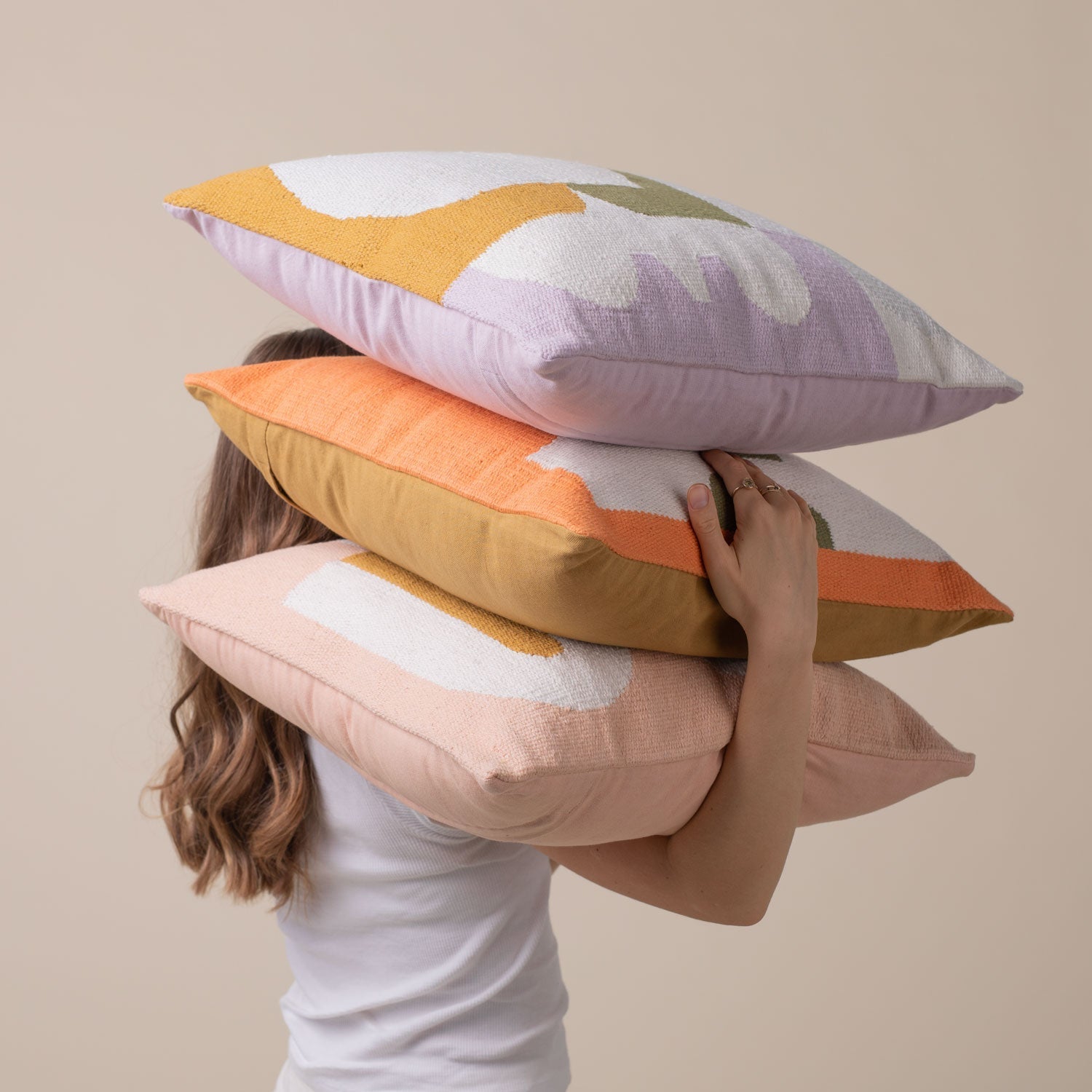Pillows: the unsung heroes of home. From late-night movies to midday naps, they’re always there—cradling heads, catching crumbs, and making everything feel a little softer. But even the best bed pillows need a reset every now and then. Whether you're freshening up a favorite Slowdown Studio throw pillow or deep-cleaning a dirty pillow that’s been through the wringer, the way you wash matters.
So let’s talk about washing pillows—without ruining their shape, their soul, or that perfect lived-in vibe.

Start with the Care Instructions
Before you do anything else, check the washing instructions. Trust us—each pillow type comes with its own preferences. That little care label? It's basically a love note telling you exactly how to keep your pillow happy. If you have a Slowdown Studio Elyse Throw Pillows by designed by German artist Marc David Spengler, you can check out the care instructions here.
Some types of pillows—like synthetic pillows, feather pillows, or bedding pillows—handle the washing machine just fine. Others, like memory foam pillows, require a gentler, hands-on approach. When in doubt, always defer to the care instructions to preserve shape and softness.
The Art of the Pre-Wash Ritual
Before washing, remove any removable cover or pillow protector. These pieces often need more frequent cleaning than the insert itself. Pillow protectors are great at guarding against dust mites, germs in pillows, and snack-time mishaps—but they can’t do it all alone.
Want to keep things fresher longer? Opt for natural materials and add a regular wash rotation into your pillow care routine.

Machine Washing Pillows (The Right Way)
If the tag says “machine washable,” congratulations—you’ve got a wash-friendly piece of bedding on your hands. Here’s how to do it without a fabric freak-out:
- Wash two pillows at a time to keep the load balanced
- Place pillows vertically in the drum to improve water flow
- Use cold water and a delicate cycle or delicate setting
- Reach for a gentle detergent or mild detergent—bonus points if it’s fragrance-free
- Run an extra rinse cycle with fresh water to make sure all that soapy water is gone
These simple switches can help preserve your pillow’s shape, prevent odors from pillows, and protect even high-quality pillows from damage.
The Lowdown on Drying
Drying is where most of the magic (and mistakes) happen. For best results:
- Toss pillows in the dryer on low heat with dryer balls or tennis balls to re-fluff
- Or air-dry flat in a well-ventilated space, flipping regularly
- Skip direct sunlight—it can cause fading, fiber breakdown, or weird discoloration (not the vibe)
Drying slowly helps reset shape, eliminate residual moisture, and reduce lingering germs in pillows.
Hand-Washing for the Sensitive Souls
Got a pillow type that’s too tender for the washing machine? You can still get it clean without drama.
- Fill a sink or tub with clean water and a splash of mild detergent
- Submerge the pillow gently, squeezing (not wringing!) to cleanse
- Use a soft sponge to target tough stains
- Rinse thoroughly with fresh water
- Gently press out moisture, wrap in a towel, and dry flat
This method takes a little more effort—but like all good rituals, it’s worth it.

How to Clean Memory Foam Pillows
Memory foam pillows need special treatment. They're all about contour and structure, so the wrong move (like a spin cycle) can wreck them.
Instead:
- Spot clean with a cloth and gentle detergent
- Dab—never scrub
- Let air dry completely before use
This helps maintain support while removing surface dirt, oils, and that subtle-but-annoying funk.
Don’t Forget the Pillow Covers
If you're working with Slowdown Studio throw pillow covers, treat them like the artful textiles they are. Many are made from natural fibers and appreciate a softer touch.
- Only ever spot clean or dry clean when possible
- If machine-washable, use cold water + delicate cycl
- Air dry flat or tumble dry on low
These pieces don’t just hide your inserts—they're part of the story your space is telling. Care for them accordingly.
So… How Often Should You Wash Pillows?
Keeping a regular pillow-washing rhythm is the secret to freshness and better sleep quality.
- Wash pillow inserts every 3–6 months
- Wash pillow covers every 2–4 weeks (more often if they’re part of your everyday setup)
- Wash pillow protectors monthly to keep the inner core cleaner longer
This schedule reduces allergens, dust, odors from pillows, and keeps your whole selection of pillows feeling guest-ready, always.
Signs It's Time for Alternative Pillows
Even the most loved pillow has a lifespan. If you notice any of these, it may be time to explore alternative pillows:
- Permanent lumps or a misshapen silhouette
- Persistent smells, even post-wash
- Neck or back pain upon waking
- A general vibe of “this isn’t it anymore”
We get it—goodbye is hard. But a new pillow might be the refresh your sleep quality needs.
👉 Explore our selection of pillows →
Storage Tips That Protect Your Pillows
Not using that pillow right now? Store it smart:
- Use breathable cotton bags (skip plastic)
- Keep it in a dry, cool place away from moisture and dust
- Add a cedar block or lavender sachet to keep things smelling like calm
Proper storage = longer-lasting fluff, better hygiene, and one less dirty pillow to deal with later.
Design Deserves Better Care
Washing your pillows isn’t just about looks—it’s about honoring the objects that hold your downtime. A clean pillow means deeper rest, less irritation, and a more thoughtful home.
Whether it’s a sculptural throw pillow perched on your sofa or your go-to bed pillow for sweet dreams, every piece deserves care that matches its design.
For Slowdown Studio inspo or to check out our artist designed woven blankets, be sure to check out our instagram or pinterest.



